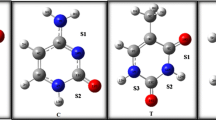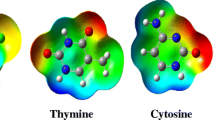Abstract
In this study, the biologically active configurations composed of Thiazolidinedione–Uracil (TU) and Rhodanine–Uracil (RU) have been fully investigated from the energetic and structural points of view, employing B3LYP and M062X functionals in combination with the different basis sets. Dispersion corrections to the interaction energy using M062X–GD3 and double hybrid density functionals (B2PLYP–GD2, B2PLYP–GD3 and mPW2PLYP–GD2) are also taking into account. The basis set superposition error-corrected interaction energy for hydrogen bonded configurations ranges from − 5.27 to − 13.53 and − 5.25 to − 12.93 kcal/mol for TU and RU complexes respectively as calculated at M062X/6–311++G(df,pd) level. The charge transfer process within all of the TU and RU configurations were analyzed using Natural Bond Orbital (NBO) calculations. The nature of the interactions is analyzed with NBO and Atoms in Molecules (AIM) analysis at M062X/6–311++G(df,pd) and energy decomposition analysis at BP86–D3/TZ2P(ZORA)//M062X/6–311++G(df,pd) level of theory. The results confirm that the nature of the interactions is nearly electrostatic, with a contribution of about 51–56% of the total interaction energy. The orbital interactions (ΔEorb) for the considered TU and RU complexes have a contribution of about 24–38% of the total interaction energy. Based on the AIM and NBO results, the interactions were defined as electrostatic H-bonds with partially covalent character. In addition, correlation between interaction energies and vibrational frequency changes was investigated.















Similar content being viewed by others
References
Müller–dethlefs K, Hobza P (2000) Noncovalent interactions: a challenge for experiment and theory. Chem Rev 100:143–168
Rudkevich DM (2004) Emerging supramolecular chemistry of gases. Angew Chem Int Ed 43:558–571
Saalfrank RW, Maid H, Scheurer A (2008) Supramolecular coordination chemistry: the synergistic effect of serendipity and rational design. Angew Chem Int Ed 47:8794–8824
Chalasinski G, Szczesniak MM (2000) State of the art and challenges of the ab initio theory of intermolecular interactions. Chem Rev 100:4227–4252
Scheiner S (2015) Non-covalent forces. Springer, Germany
Zhao Q (2017) Theoretical study of noncovalent interactions in XCN··· YO2H (X= F, Cl, Br, I; Y= P, As, Sb) complexes. J Mol Model 23:188
Scheiner S (1997) Hydrogen bonding: a theoretical perspective. Oxford University Press, New York
Behzadi H, Esrafili MD, Hadipour NL (2007) A theoretical study of 17 O, 14 N and 2 H nuclear quadrupole coupling tensors in the real crystalline structure of acetaminophen. Chem Phys 333:97–104
Esrafili MD, Behzadi H, Beheshtian J, Hadipour NL (2008) Theoretical 14 N nuclear quadrupole resonance parameters for sulfa drugs: sulfamerazine and sulfathiazole. J Mol Graph Model 27:326–331
Dkhissi A, Blossev R (2007) Performance of DFT/MPWB1K for stacking and H-bonding interactions. Chem Phys Lett 439:35–39
Anslyn E (2004) Modern physical organic chemistry. University Science, Sausalito
Jain A, Wang G, Vasquez KM (2008) DNA triple helices: biological consequences and therapeutic potential. Biochimie 90:1117–1130
Emsley J (1980) Very Strong Hydrogen Bonds. Chem Soc Rev 9:91–124
Hunter KC, Wetmore SD (2006) Hydrogen-bonding between cytosine and water: computational evidence for a ring-opened complex. Chem Phys Lett 422:500–506
Wieczorek R, Dannenberg JJ (2003) Hydrogen-bond cooperativity, vibrational coupling, and dependence of helix stability on changes in amino acid sequence in small 310-helical peptides. A Density Functional Theory Study. J Am Chem Soc 125:14065–14071
Solimannejad M, Rezaei Z, Esrafili MD (2013) Competition and interplay between the lithium bonding and hydrogen bonding: R3C···HY···LiY and R3C···LiY···HY triads as a working model (R=H, CH3; Y=CN, NC). J Mol Model 19:5031–5035
Vojta D, Vazdar M (2014) The study of hydrogen bonding and π⋯π interactions in phenol⋯ethynylbenzene complex by IR spectroscopy. Spectrochim Acta A Mol Biomol Spectrosc 132:6–14
Esrafili MD, Amiri Z, Shankal F (2016) Strong cooperative effects between π-hole and dihydrogen bonds interactions: a computational study. Mol Phys 114:2315–2324
Afzali R, Vakili M, Nekoei AR, Tayyari SF (2014) Intramolecular hydrogen bonding and vibrational assignment of 1,1,1-trifluoro-5,5-dimethyl-2,4-hexanedione. J Mol Struct 1076:262–271
Esrafili MD, Behzadi H (2012) A theoretical study on H-bonding interactions in maleic acid: calculated 17O, 1H NMR parameters and QTAIM analysis. Mol Simul 38:896–905
Zheng YZ, He HY, Zhou Y, ZW Y (2014) Hydrogen-bonding interactions between [BMIM][BF4] and dimethyl sulfoxide. J Mol Struct 1069:140–146
Vojta D, Matanović I, Kovačević G, Baranović G (2014). Spectrochim Acta A Mol Biomol Spectrosc 132:215–224
Esrafili MD, Vakili M (2017) The effect of hydrogen-bonding cooperativity on the strength and properties of σ-hole interactions: an ab initio study. Mol Phys 115:913–924
Rezaei Z, Solimannejad M, Esrafili MD (2015) Interplay between hydrogen bond and single-electron tetrel bond: H3C⋯COX2⋯HY and H3C⋯CSX2⋯HY (X = F, Cl; Y = CN, NC) complexes as a working model. Comput Theor Chem 1074:101–106
Garrett RH, Grisham CM (1997) Principals of biochemistry with a human focus. Brooks/Cole Thomson Learning, United States
Brown DJ (1994) Heterocyclic compounds: thy pyrimidinesboner, vol 52. Interscience, New York
Brown EG (1998) Ring nitrogen and key biomolecules: the biochemistry of N-heterocycles. Kluwer Academic Publishers, Boston
Hidalgo A, Pompei C, Galli A, Cazzola S (2005) Uracil as an index of lactic acid bacteria contamination of tomato products. J Agric Food Chem 53:349–355
Pozharskii AF, Soldatenkov AT, Katritzky AR (1997) Heterocycles in life and society: an introduction to heterocyclic chemistry and biochemistry and the role of heterocycles in science, technology, medicine, and agriculture. John Wiley and Sons, New York
Swath N, Ramu Y, Subrahmanyam CVS, Satyanarayana K (2012) Synthesis, quantum mechanical calculation and biological evaluation of 5-(4-substituted aryl/hetero aryl methylidene)-1, 3-thiazolidine-2, 4-diones. Int. J Pharm Sci 4:632–637
Sharmaa P, Reddyb TS, Thummuric D, Senwara KR, Kumara NP, Naiduc VGM, Bhargavab KS, Shankaraiah N (2016) Synthesis and biological evaluation of new benzimidazole-thiazolidinedione hybrids as potential cytotoxic and apoptosis inducing agents. Eur J Med Chem 124:608–621
Jain VS, Vora DK, Ramaa CS (2013) Thiazolidine-2,4-diones: progress towards multifarious applications. Bioorg Med Chem 21:1599–1620
Iqbal AKM, Khan AY, Kalashetti MB, Belavagi NS, Gong YD, Khazi IAM (2012) Synthesis, hypoglycemic and hypolipidemic activities of novel thiazolidinedione derivatives containing thiazole/triazole/oxadiazole ring. Eur J Med Chem 53:308–315
Verma SK, Thareja S (2016) Molecular docking assisted 3D-QSAR study of benzylidene-2,4-thiazolidinedione derivatives as PTP-1B inhibitors for the management of type-2 diabetes mellitus. RSC Adv 6:33857–33867
Liu XF, Zheng CJ, Sun LP, Liu XK, Piao HR (2011) Synthesis of new chalcone derivatives bearing 2,4-thiazolidinedione and benzoic acid moieties as potential anti-bacterial agents. Eur J Med Chem 46:3469–3473
Romagnoli R, Baraldi PG, Salvador MK, Camacho ME, Balzarini J, Bermejo J, Estévez F (2013) Anticancer activity of novel hybrid molecules containing 5-benzylidene thiazolidine-2,4-dione. Eur J Med Chem 63:544–557
Arafa WAA, Fareed MF, Rabeh SA, Shaker RM (2016) Ultrasound mediated green synthesis of rhodanine derivatives: synthesis, chemical behavior, and antibacterial activity. Phosphorus Sulfur Silicon Relat Elem 191:1129–1136
Ali Muhammad S, Ravi S, Thangamani A (2016) Synthesis and evaluation of some novel N-substituted rhodanines for their anticancer activity. Med Chem Res 25:994–1004
Brown FC, Bradsher CK (1951) Mildew-preventing activity of rhodanine derivatives. Nature 168:171–172
Prashantha Kumar BR, Baig NR, Sudhir S, Kara K, Karana M, Pankaj M, Joghee NM (2012) Discovery of novel glitazones incorporated with phenylalanine and tyrosine: synthesis, antidiabetic activity and structure–activity relationships. Bioorg Med Chem 45:12–28
Jacobine AM, Posner GH (2011) Three-component, one-flask synthesis of rhodanines (thiazolidinones). J Org Chem 76:8121–8125
Kamila S, Ankati H, Harry E, Edward RB (2012) A facile synthesis of novel 3-(aryl/alkyl-2-ylmethyl)-2-thioxothiazolidin-4-ones using microwave heating. Tetrahedron Lett 53:2195–2198
Khalili B (2016) A quantum chemical insight to intermolecular hydrogen bonding interaction between cytosine and nitrosamine: structural and energetic investigations. J Mol Struct 1107:162–173
Khalili B, Rimaz M, Tondro T (2015) DFT study on foscarnet as an antiviral drug: conformer analysis, gas phase acidity, metal ion affinity and influence of metal complexation on gas phase acidity. J Mol Struct 1080:80–87
Khalili B, Rimaz M (2017) An investigation on the physicochemical properties of the nanostructured [(4-X)PMAT][N(CN)2] ion pairs as energetic and tunable aryl alkyl amino tetrazolium based ionic liquids. J Mol Struct 1137:530–542
Khalili B, Rimaz M (2017) Does interaction between an amino acid anion and methylimidazolium cation lead to a nanostructured ion pairs of [Mim][AA] as an ionic liquid? J Mol Liq 229:267–277
Khalili B, Rimaz M (2017) Interplay between non-covalent pnicogen bonds and halogen bonds interactions in ArH2N---PH2FO---BrF nanostructured complexes: a substituent effects investigation. Struct Chem 28:1065–1079
Khalili B (2016) An insight into the interaction of L-proline with the transition metal cations Fe2+, Co2+, Ni2+: a gas phase theoretical study. J Mol Model 22:11
Khalili B, Rimaz M (2016) Interaction of l-proline with group IIB (Zn2+, Cd2+, Hg2+) metal cations in the gas and aqueous phases: a quantum computational study. Can J Chem 94:501–508
Reed AE, Curtiss LA, Weinhold F (1988) Intermolecular interactions from a natural bond orbital, donor-acceptor viewpoint. Chem Rev 88:899–926
Bader RFW (1990) Atoms in molecules: a quantum theory. Clarendon Press, Oxford
Bader RFW, Essen HJ (1994) The characterization of atomic interactions. J Chem Phys 80:1943–1960
Bader RFW (1998) 1997 Polanyi Award Lecture: why are there atoms in chemistry? Can J Chem 76:973–988
Szczesniak MM, Latajka Z, Scheiner SJ (1986) The contribution of dispersion to H-bonds between hydrides of first and second-row atoms. J Mol Struct (THEOCHEM) 135:179–188
Grimme S (2006) Semiempirical hybrid density functional with perturbative second-order correlation. J Chem Phys 124:034108
Schwabe T, Grimme S (2006) Towards chemical accuracy for the thermodynamics of large molecules: new hybrid density functionals including non-local correlation effects. Phys Chem Chem Phys 8:4398–4401
Schwabe T, Grimme S (2007) Double-hybrid density functionals with long-range dispersion corrections: higher accuracy and extended applicability. Phys Chem Chem Phys 9:3397–3406
Pakhira S, Debnath T, Sen K, Das AK (2016) Interactions between metal cations with H2 in the M+- H2 complexes: performance of DFT and DFT-D methods. J Chem Sci 128:621–631
Granovsky AA PC GAMESS (Version 7.1. http://classic.chem.msu.su/gran/ gamess/index.html)
Biegler-Konig F (2000) AIM2000 (University of Applied Sciences, Bielefeld)
Glendening DE, Reed AE, Carpenter JE, Weinhold F NBO, Version 3.1
Hobza P, Havlas Z (2000) Blue-shifting hydrogen bonds. Chem Rev 100:4253–4264
Shakourian–Fard M, Fattahi A, Bayat A (2012) Ionic liquid based on α-amino acid anion and N7,N9-dimethylguaninium cation ([dMG][AA]): theoretical study on the structure and electronic properties. J Phys Chem A 116:5436–5444
Popelier PLA (1998) Characterization of a dihydrogen bond on the basis of the electron density. J Phys Chem A 102:1873–1878
Acknowledgments
Support of this work from the Research Council of the University of Guilan is gratefully appreciated. We also thank Professor Rolf H. Prager for proof reading this article.
Author information
Authors and Affiliations
Corresponding author
Ethics declarations
Conflict of interest
The authors declare that they have no conflict of interest.
Rights and permissions
About this article
Cite this article
Khalili, B., Rimaz, M. A quantum chemical study of the interactions of uracil as a constituent of ribonucleic acid (RNA) with thiazolidinedione and rhodanine bioactive molecules: an insight into energetic and structural features. Struct Chem 29, 681–702 (2018). https://doi.org/10.1007/s11224-017-1062-4
Received:
Accepted:
Published:
Issue Date:
DOI: https://doi.org/10.1007/s11224-017-1062-4




